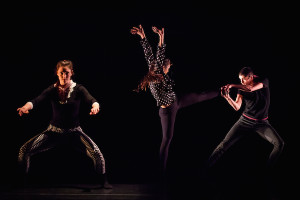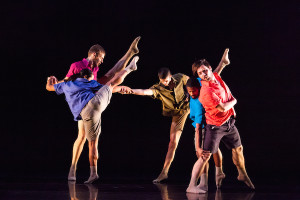NobleMotion Pairs with Musiqa to Give us Tonal Impact
by Neil Ellis Orts
NobleMotion Dance has been a centerpiece of the Houston dance scene since they started producing work in 2009. Known for their tightly choreographed athleticism and use of technology they always bring a bit of spectacle to the stage. Teaming up with Musiqa for an evening in Zilkha Hall, the Hobby Center, the two arts groups presented Tonal Impact on April 24 and 25. NobleMotion used the night to show the range of their work.
The evening opener, Motorcycle for Moses, was an example of the company’s virtuosity. The piece evolved and dissolved from solos to duets to groups, back to solo movement. I don’t know who Moses is (I don’t want to presume the biblical figure), and there are clues that there is a narrative about motorcycles going on (a more obvious moment being when a dancer paused downstage, audience left, legs wide as if astride a Harley, gently rock to the John Adams score). What really mattered, however, was that the show opened with the precision and technical flair NobleMotion has so often given audiences.
The traditional curtain talk came untraditionally after this first piece and was given by composer Marcus Maroney. Most significantly, he set the stage for the dance-less second piece, composer Philippe Manoury’s Ultima. A trio for piano, clarinet, and cello, Maroney noted that we would not be whistling a melody afterward, but that the piece was about the different ways the instruments create sound, by hammer, breath, or bow.
I did listen for this conversation. The piano seemed most insistent, dominating the dialog with feet-stomping fits of temper, with the clarinet and cello being more conciliatory—although the clarinet did let out a few shrieks of defiance. Not being a music writer (though experienced enough to wonder what the score looked like—did it even have a time signature?), I don’t want to say too much lest I embarrass myself (further) in front of the music community, but I will say that I imagine this is the sort of composition that people are talking about if they complain about contemporary music. For my part, I was glad to lend my ears to this and am happy for the challenge it presented.
The centerpiece of the evening, both literally and for me personally, was the 2014 piece, Harvest, set to String Trio by Pierre Jalbert. While the choreography was contemporary in style and composition, it has the feel of classic modern dance, a piece of big themes and sweeping emotion. There is reverence in this dance, perhaps pointing to forces bigger than we can control. It occurred to me while watching that Harvest could be compatible with some religious settings, at least ones that allow for lament and supplication in their rituals. This is not a “thanksgiving” piece. If this is a harvest, it is one that followed a hard growing season. The arms raised may be seen as thanksgiving, but there is also, perhaps, the hard hope that what was gathered would be enough to sustain the harvesters through the winter ahead. The piece ends with most of the company on the floor, presumably given in to exhaustion. Two dancers remain active, leaving us with a picture of the two repeated images throughout the dance—one on her knees, the other standing upright, his arms reaching to the sky. Both could be in prayers of praise or petition.
During the intermission, two quite large screens were placed on stage for another 2014 piece of choreography, a CrB, an excerpt from NobleMotion’s evening length program, Dark Matter. Layered images are projected on the screens as dancers perform in front of them, giving us three images of the choreography, one “life size” and two much larger than life and in mirrored image. Dionne Noble, choreographer for this piece, tells us in the program notes that a CrB is a “binary star in the constellation Corona Borealis.” The dancers, then, are competing to be, somewhat literally, the star as they replace one another in front of the screens. It is the most technology-heavy piece of the evening and a reminder of how well the company does spectacle. It mattered not at all that the fog machines set off the fire alarms the night I saw it. The noise and the added flashing lights, at least at first, seemed part of the multi-sensory experience.
Some years ago, NobleMotion received some attention for a collaboration with the late lighting designer, Jeremy Choate. In that collaboration, the Nobles gave Choate the task of creating light environments within which the Nobles would then create dances—an upside down approach to staging dance. For this show, they do something similar with composer Marcus Maroney. The Nobles created a dance without music and asked Maroney to create music for the movement. The result is Two Shades of Gay. The choreography for this piece is looser, intentionally gangly to convey the awkwardness of adolescence. Maroney felt a waltz beat in the choreography and commenced to create music in that genre, although slipping in and out of it throughout the composition. Maroney said in his afore-mentioned curtain talk that he was musically playing with the romance of the waltz but also with the expectations of it, the traditional gender roles within it. These intentions were no doubt spurred by the choreography. There are tentative tries at making romantic connections throughout the dance, eventually finding everyone pairing off. Some couples are boy-girl, others are girl-girl or boy-boy. It’s a sweet dance, a pleasant closer to a fine night of music and dance.
When people ask me about local dance companies to see, I always recommend watching for the next NobleMotion show. Tonal Impact reinforced this advice. They are a company that continues to grow and experiment while maintaining a high standard of performance and production.






Recent Comments